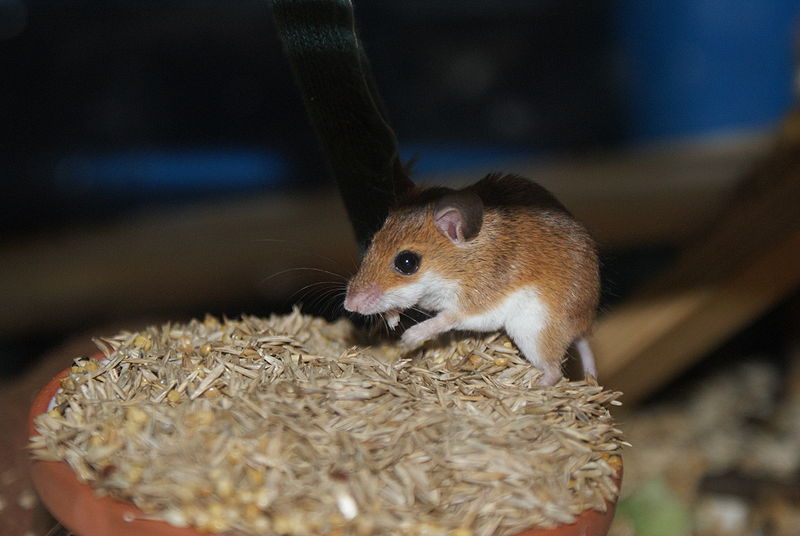 It’s well known that whole animals, complete with skin and internal organs, are the best source of nutrition for most carnivorous reptiles and amphibians. Hobbyists keeping and breeding small species that fee upon mammals must often cut pink mice and similar food items into pieces in order to feed their collections. In doing so, important nutrients are lost, and health, especially in the case of growing animals, usually suffers. The African Pygmy Mouse (Mus minutoides) provides one possible solution to this problem.
It’s well known that whole animals, complete with skin and internal organs, are the best source of nutrition for most carnivorous reptiles and amphibians. Hobbyists keeping and breeding small species that fee upon mammals must often cut pink mice and similar food items into pieces in order to feed their collections. In doing so, important nutrients are lost, and health, especially in the case of growing animals, usually suffers. The African Pygmy Mouse (Mus minutoides) provides one possible solution to this problem.
Captive History
I first ran across the Pygmy Mouse while working for an animal importer in NYC who supplied exotic rodents to US zoos. The little fellows were fascinating, and despite their diminutive size (at 1.2-3 inches, they can perch comfortably on a quarter!), they were quite popular zoo exhibits and, for a time, pets. In fact, one difficulty in breeding them as a food item is that folks often find them too interesting and endearing to part with!
Mouse Engineers
Pygmy Mice range through much of Sub-Saharan Africa. While not the smallest of mammals (Thailand’s Kittie’s Hog-Nosed Bat is bumblebee sized, and North America’s Pygmy Shrew is not much larger), they are the tiniest furred creatures most people will ever see.
In arid regions Pygmy Mice gather water by piling pebbles at their burrow’s entrance at night. The warm air from the burrow collides with the cooler evening air above ground, creating condensation that is licked off the pebble piles each morning – most ingenious!
Use as Herp Food
Pygmy Mouse pinkies are barely the size of pencil erasers, and therefore well-suited for use for tiny snakes, especially those that refuse all but live food. In zoo collections, I’ve found them to be invaluable when raising Eyelash Vipers (note: Eyelash Vipers are venomous and should not be kept at home, despite the fact that they are sometimes offered for sale).
They are also an ideal solution for a problem that arises when keeping certain large, insectivorous lizards, frogs and salamanders. American Bullfrogs, Basilisks, Tiger Salamanders and many others need a good deal of calcium, which is easily supplied by feeding typical pink mice (baby House Mice). However, when fed a steady diet of House Mouse pinkies insectivorous herps often develop fat deposits in the eye and liver problems. The tiny Pygmy Mice pinkies may be “easier” on their digestive systems, providing high quality calcium and dietary variety without the side effects.
Further Reading
Video of a female caring for her tiny youngsters.
Please see my article Feeding Large Insectivorous Amphibians and Reptiles for additional information.
 That Reptile Blog – Reptile, Amphibian and Exotic Pet Care and Information
That Reptile Blog – Reptile, Amphibian and Exotic Pet Care and Information



I’ve bred these for years. They are simultaneously pets as well as feeders, but they’re “watch me” pets rather than “play with me” pets. They don’t like a lot of commotion! They are active at night, so you almost never see them in the daytime, but if you’re a night owl you’ll get to enjoy them plenty. They’re not hugely prolific – 2 babies is typical, 4 is generally the max – but they do breed pretty steadily once they’re established.
I’ve heard it said that they will not drink from a water bottle; not true, they certainly do. They also enjoy a small rodent wheel, although it sometimes takes 2 or 3 mice to get it to turn! 🙂 They eat the typical rodent diet of small seeds, plus the occasional vegetables, and periodic insects (mealworms are big favorites). The only caution, aside from disturbing them too much, is overcrowding; if the population gets too dense, they will turn on members of the colony and kill them. Too much disturbance will cause the parents to eat their babies, so I only clean the cages every few weeks.
As feeders they have a big advantage because they’re a wild species and not a domestic, so they have that “wild mouse” scent. There’s a certain size limitation on what you can feed them to, of course, but some animals who won’t eat domestic mice can get started on pygmies. I’ve found that my Aesculapian snakes prefer pygmy mice above all else – but they’re rapidly outgrowing them, and I’m going to have to wean them onto another food source soon.
Anyway, I highly recommend this species!
Hello Raksha, Frank Indiviglio here.
Thanks for the interesting observations; I’ve often felt the same concerning “food animals” – many are so interesting that I up keeping them as part of my permanent collection, for their own sake. Pygmy mice are right at the top of my list.
Good point concerning scent, as that can be critical in inducing snakes to feed. I recall a green anaconda that refused lab raised Norway rats but accepted those I trapped on zoo grounds – exact same species, but likely a different scent.
Good luck and please keep me posted.